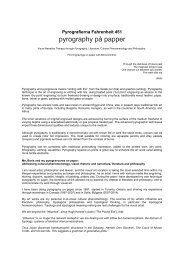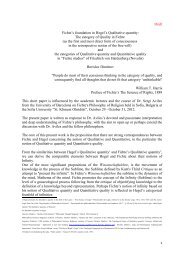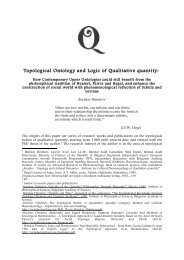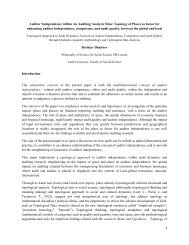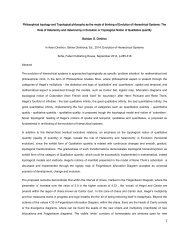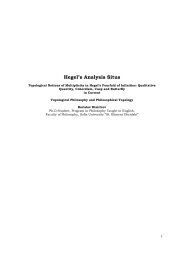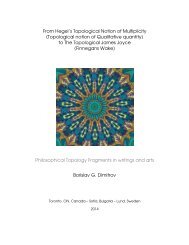o_194c354f0fne14b05mcimi6ppa.pdf
Create successful ePaper yourself
Turn your PDF publications into a flip-book with our unique Google optimized e-Paper software.
exploits it, parasites it and deciphers it, is no doubt the minute parcel detached from the<br />
other, the metonymic dwarf, the jester of the great anterior text [...] and yet it is also another<br />
set, quite other, bigger, and more powerful than the all-powerful which it drags off and<br />
reinscribes elsewhere in order to defy its ascendancy. Each writing is at once the detached<br />
fragment of a software more powerful than the other, a part larger than the whole of which it<br />
is a part./32/<br />
According to Louis Armand, this topological structure of the relationship between two<br />
textual programmes, describes a species of mise en abyme, wherein a "totality" "is<br />
represented on the model of one of its parts which thus becomes greater than the whole of<br />
which it forms a part, which it makes into a part"; a metonymic "chain of substitutions," of<br />
the supplement [Nachtrag], or operation of "decentring," which suggests analogies to what<br />
the mathematician Henri Poincare termed the "Vicious Circle Principle" and which Bertram<br />
Russell in 1908 defined as an exclusion of metonymic totality./33/ This metaphor describes a<br />
two-fold relation contiguous to Georg Cantor’s set continuum problem, which also came to<br />
pre-occupy Gottlob Frege and Bertram Russell. The first is the ambivalent set between two<br />
writing/translation softwares, in which one is a "minute" and "metonymic dwarf" which is<br />
nonetheless "detached from" and able to "exploit" the other. The second is the equivalent set<br />
of relations between two softwares in which both are a "detached fragment of a software"<br />
and, simultaneously, a "software more powerful than the other" and a "part larger than the<br />
whole of which it is a part." For Russell, "whatever involves all of a collection must not<br />
[itself] be one of the collection." /34/<br />
The idea of Joyce's text as a kind of machine has also been treated by Jean-Michel Rabate. In<br />
his essay titled 'Lapsus ex machina,'/35/ Rabate examines “Finnegans Wake” as a "system<br />
which can be described as a word machine, or a complex machination of meanings," a<br />
"perverse semic machine" which "has the ability to distort the classical semiological relation<br />
between "production" and "information," by disarticulating the sequence of encoding and<br />
decoding". Joyce's paronomasian and polyphonic writing, we might say, demonstrates that<br />
"[w]hat can't be coded can be decorded, if an ear aye seize what no eye ere grieved for" (FW<br />
482.34). By dis-articulating the received phonic-graphic binary, Joyce's writing also<br />
destabilises classical notions of meaning and comprehension, forcing the reader to (re-<br />
)assemble the semantic horizons of a text with whatever is near at hand.<br />
According to Armand:<br />
“In the "Mamafesta" section of Finnegans Wake (I.5), this set theoretical principle of<br />
metonymic exclusion is posed against the function of A.L.P.’s letter ("Anna’s gramme")–a<br />
"metonymic dwarf" of Joyce’s "nightbook" as a whole, in which the letters A.L.P. (nominally<br />
"Anna Livia Plurabelle") simultaneously describe the recurrent "vicious circle" of a Freudian<br />
repetition compulsion in which the form Alp is also, for example, the German word for<br />
nightmare. As this "epistolear" becomes more and more a part of the textual apparatus that<br />
surrounds it, and less distinguishable from its own analysis or exegesis, it begins to take on a<br />
mythological aura as the site of endless co-ordinates for an impossible rendez-vous with<br />
itself. Like the letters A.L.P. and H.C.E., this "nightletter" serves as a kind of topological, or<br />
tropological site of what Jean-Michel Rabate terms a lapsus–a point of "continuity" which at<br />
the same time marks out a chain of "dis-continuities," or the symptomatic "disarticulation" of<br />
a sequence of encoding and decoding.<br />
Borislav G. Dimitrov 147





